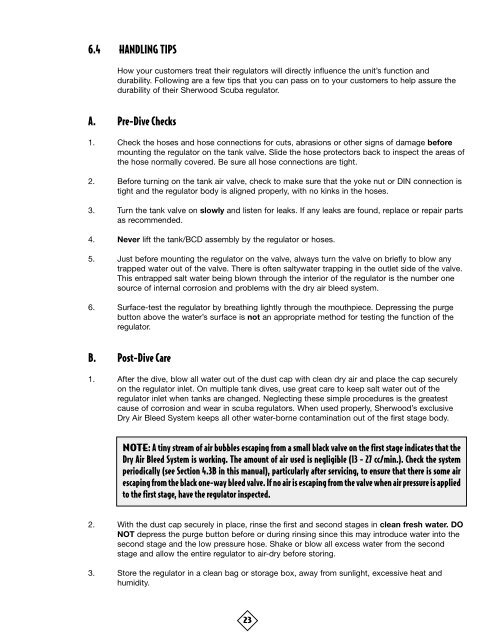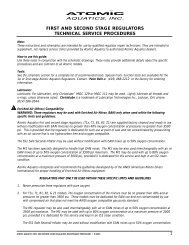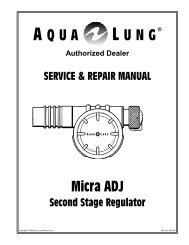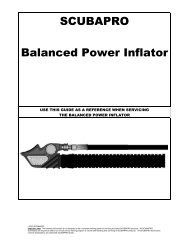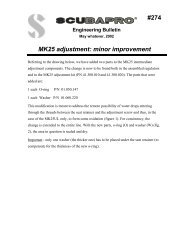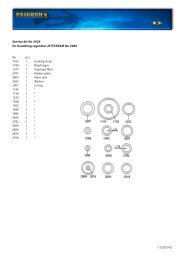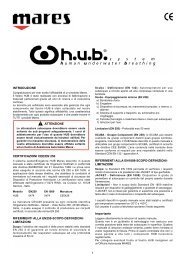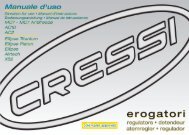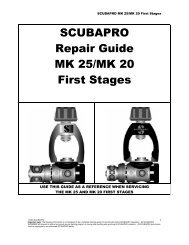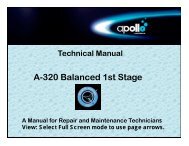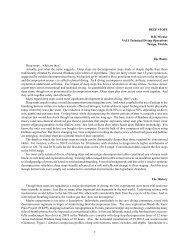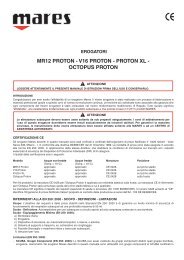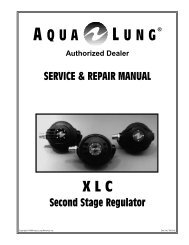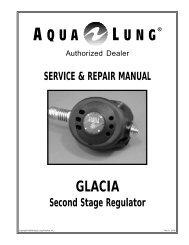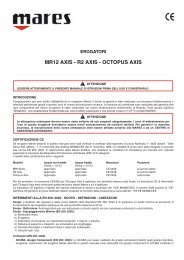SRB5600.pdf1687 KBytes - Frogkick.dk
SRB5600.pdf1687 KBytes - Frogkick.dk
SRB5600.pdf1687 KBytes - Frogkick.dk
You also want an ePaper? Increase the reach of your titles
YUMPU automatically turns print PDFs into web optimized ePapers that Google loves.
6.4 HANDLING TIPS<br />
How your customers treat their regulators will directly influence the unit’s function and<br />
durability. Following are a few tips that you can pass on to your customers to help assure the<br />
durability of their Sherwood Scuba regulator.<br />
A. Pre-Dive Checks<br />
1. Check the hoses and hose connections for cuts, abrasions or other signs of damage before<br />
mounting the regulator on the tank valve. Slide the hose protectors back to inspect the areas of<br />
the hose normally covered. Be sure all hose connections are tight.<br />
2. Before turning on the tank air valve, check to make sure that the yoke nut or DIN connection is<br />
tight and the regulator body is aligned properly, with no kinks in the hoses.<br />
3. Turn the tank valve on slowly and listen for leaks. If any leaks are found, replace or repair parts<br />
as recommended.<br />
4. Never lift the tank/BCD assembly by the regulator or hoses.<br />
5. Just before mounting the regulator on the valve, always turn the valve on briefly to blow any<br />
trapped water out of the valve. There is often saltywater trapping in the outlet side of the valve.<br />
This entrapped salt water being blown through the interior of the regulator is the number one<br />
source of internal corrosion and problems with the dry air bleed system.<br />
6. Surface-test the regulator by breathing lightly through the mouthpiece. Depressing the purge<br />
button above the water’s surface is not an appropriate method for testing the function of the<br />
regulator.<br />
B. Post-Dive Care<br />
1. After the dive, blow all water out of the dust cap with clean dry air and place the cap securely<br />
on the regulator inlet. On multiple tank dives, use great care to keep salt water out of the<br />
regulator inlet when tanks are changed. Neglecting these simple procedures is the greatest<br />
cause of corrosion and wear in scuba regulators. When used properly, Sherwood’s exclusive<br />
Dry Air Bleed System keeps all other water-borne contamination out of the first stage body.<br />
NOTE: A tiny stream of air bubbles escaping from a small black valve on the first stage indicates that the<br />
Dry Air Bleed System is working. The amount of air used is negligible (13 - 27 cc/min.). Check the system<br />
periodically (see Section 4.3B in this manual), particularly after servicing, to ensure that there is some air<br />
escaping from the black one-way bleed valve. If no air is escaping from the valve when air pressure is applied<br />
to the first stage, have the regulator inspected.<br />
2. With the dust cap securely in place, rinse the first and second stages in clean fresh water. DO<br />
NOT depress the purge button before or during rinsing since this may introduce water into the<br />
second stage and the low pressure hose. Shake or blow all excess water from the second<br />
stage and allow the entire regulator to air-dry before storing.<br />
3. Store the regulator in a clean bag or storage box, away from sunlight, excessive heat and<br />
humidity.<br />
23


